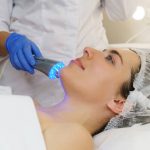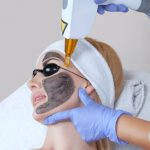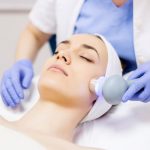Laser therapy that uses cold lasers beams light energy directly on the skin to help reduce the pain and inflammation in the underlying area within your body, such as the knee. It is employed to relieve knee pain caused by osteoarthritis (OA), lower back carpal tunnel syndrome, rheumatoid joint (RA), fibromyalgia nerve pain, tendinitis, and sports injuries.
Cold laser therapy was initially created during the 60s. It’s also known as low-level laser therapy (LLLT) and soft laser therapy (photobiomodulation therapy (PBMT).
How Does Cold Laser Therapy Work?
Laser therapy that is cold beams the skin with light. It uses tiny amounts of energy or photons. In contrast to lasers with higher frequencies used for surgical procedures, they do not cause heat or damage to the skin. The light beams penetrate deeply into a discomfort joint. The light stimulates chemical reactions, which help damaged tissues recover and grow.
During the procedure, your doctor points the device with a cold laser directly to the skin of the knee. It may contact your skin or be very near your skin.
The device emits a low-frequency pulse into your knee, lasting 30 to 60 minutes. It’s likely to take multiple treatments for results. It may take as little as eight or 30 medicines.
What Does Cold Laser Therapy Treat?
The use of cold lasers can be helpful:
- Lower the intensity of acute (sudden) as well as chronic (long-lasting) discomfort
- Treatment for inflammation
- Accelerate wound healing
- Help to stimulate tissue regeneration
- Enhance the circulation of blood circulation to the knee
Pros of Cold Laser Therapy for Knee Pain
Laser therapy with a cold has been proven to ease moderate to mild OA knee discomfort, increase the sensitivity of the pressure of joints, and improve joint flexibility.
It can also
- Let blood vessels open to lessen swelling
- Aid immunity by producing more chemical substances that can heal damaged tissue.
- Create more connective tissue in your knee
- Trigger endorphins, hormones naturally produced by nature that help ease the pain
Alternative to drugs. Cold laser therapy is a non-drug alternative instead of opioids for knee pain. Opioids can be highly addictive when used to treat long-term pain and may result in side effects such as constipation, nausea, and drowsiness.
Non-invasive. Cold laser therapy does not cut the skin to treat knee pain, so it’s less painful than surgery.
A few side consequences. Cold laser therapy to treat knee pain is free of harmful side consequences.
Cons of Cold Laser Therapy for Knee Pain
The outcomes of cold laser therapy could differ according to the root of knee pain, the other health issues you suffer from, or the specific laser therapy or device you choose. There’s no standard cold-laser therapy dosage or method; therefore, results may differ.
Sure, doctors are skeptical of the cold laser treatment and might be unable to recommend it. The past was when it was not sure how light effects affected tissues. Many doctors believed that cold laser therapy was a fraud. New research has proven that it can relieve pain increasing numbers of doctors are embracing it.
The setup must be precise. For cold laser therapy to work, your doctor or technician should modify the dose of light frequency, intensity, position, and duration of treatment. If any of those settings isis wrong, it may not be adequate.
Over-the-counter alternatives might not work. Although you can buy a laser machine online to use at home, it’s not ideal. The device may be reliable, but you must learn how to use it correctly, or it will not ease the discomfort.
Cost. Cold laser therapy can drain your bank account. One session of treatment could cost you up to $200. It could take at least 30 sessions to reap the benefits fully. Certain policyholders’ insurance policies might not cover cold laser treatment.
Risques to Eyes. Avoid exposing your eyes to a laser beam during treatment. You’ll need special glasses to shield your eyes. Eye.
Some people can’t do cold laser treatments. Do not undergo cold laser therapy when you suffer from one of the following conditions:
- Epilepsy, because pulsed light can trigger your seizures
- Cancer within the region being treated with lasers, which includes the skin cancer lesions
- Pregnancy because doctors aren’t aware of the effects of lasers on the pregnant fetus
Where Do You Get Treatment?
Health care professionals who provide cold laser therapy are:
- Orthopedists and orthopedic surgeons
- Physical therapy
- Rehabilitation and physical medicine physicians or physical therapists
- Chiropractors
- Trainers or sports medicine doctors
- Therapists for occupational therapy
- Naturopathic doctors




